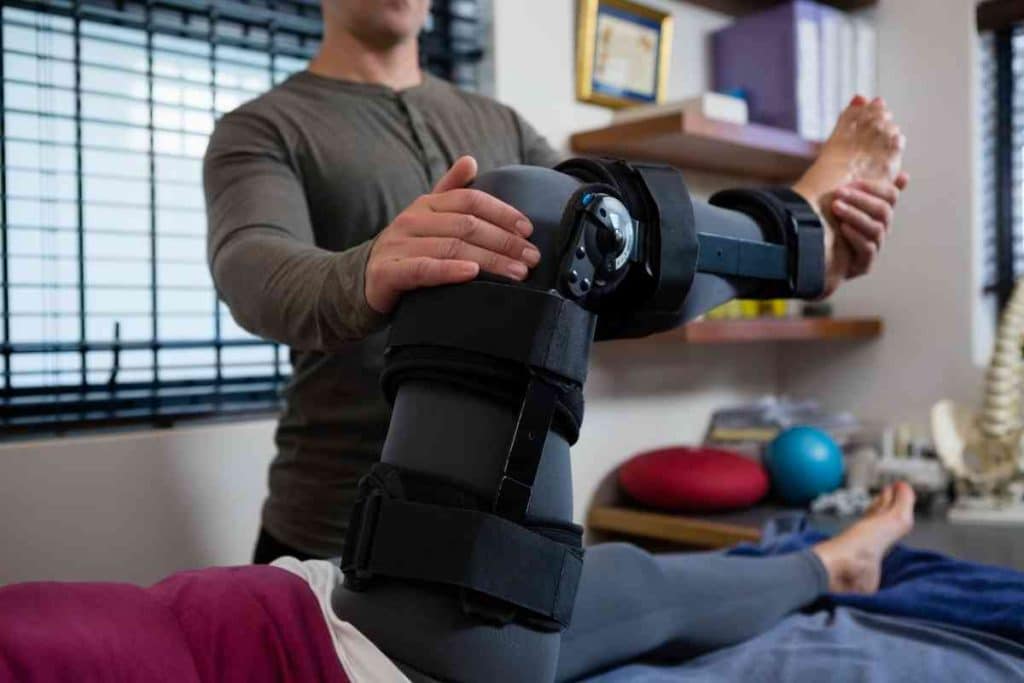If you’re considering becoming a physical therapist, or are just curious to learn more about the occupation of physical therapy in general, you may find yourself wondering if the profession of physical therapy has a high job satisfaction rate. After all, no one wants to head into a profession that has a universally low job satisfaction rating or receive treatment from a physical therapist who is miserable and doesn’t enjoy treating you.
The good news is that physical therapists of all specialities and areas of practice tend to report high job satisfaction ratings. The profession of physical therapy is also routinely ranked high within lists for the most rewarding and satisfying job professions.
To learn more about the statistics and other unique factors pertaining to job satisfaction and enjoyment that physical therapists tend to report, keep on reading!
As well, if you’re considering a career in physical therapy, be sure to check out my blog post: A Career in Physical Therapy: Here’s How to Know if it’s Right for You
Unpacking the current statistics and trends for PT job satisfaction
There can be a lot to unpack when it comes to looking at and discussing current statistics and trends for job satisfaction, so this is worth keeping in mind as you continue to read through the rest of the article.
I haven’t looked too deeply into the finer details of the polls and surveys that I mention within this article, and an academic such as myself is always approaches things with a healthy dose of reserved judgement until I learn the fine details. But, I myself am a physical therapist, so I also weigh my personal, anecdotal experiences as well when it comes to reflecting on the findings within these surveys.
Nonetheless, as we look at the following statistics, they should serve as a nice little snapshot for drawing some preliminary conclusions regarding how physical therapists are generally feeling about their job.
What are the current stats on job satisfaction across all professions?
With a quick scan of the internet via the trusty ol’ Google, there are several statistics that can be found regarding recent polls and surveys for overall job satisfaction ratings across the US. Of course, these surveys and statistics are nothing more than a brief, little snapshot of where things are currently at, but they give us some great insight to draw some general conclusions, which is what surveys are all about.
Based on a few minutes of reading different polls, a 2019 survey on job satisfaction found that 54% of US workers are satisfied with their current job, which is an improvement over previous years.
If we compare these results to the job satisfaction statistics from a recent Harris Interactive survey, only 45% of Americans within the Harris Interactive survey report being either satisfied or extremely satisfied with their jobs
With a 9% discrepancy from one survey to another (and keep in mind this is not worth drawing hard conclusions over by any means), for the sake of simplicity using only these two surveys, we’ll conclude an overall American job satisfaction percentage to be 49.5%
The general conclusion: For simplicity’s sake, and the fact that I’m only looking at two individual surveys, we will say that approximately half of all US workers feel satisfied with their current job(s). We don’t need to get scientific about this…this is a blog post, not an academically peer-reviewed paper.
What are the current stats on job satisfaction for physical therapists?
According to a study conducted by the University of Chicago in 2008, approximately 75% of physical therapists surveyed reported that they were “very satisfied” with their chosen occupation. Now, it’s not a fair fight to throw two studies against one (especially when the one study pertaining to physical therapy was performed back in 2008). And I haven’t looked into how any of these studies were performed.
But if I were to just glance at these percentages as an average individual who was not associated with the profession of physical therapy, this apparently favorable discrepancy in percentage for physical therapists would be enough for me to initially feel like there was something inherently rewarding to the field of physical therapy that maybe isn’t present with other jobs.
Financial, unemployment & job growth perspectives for physical therapists
If we consider things from a financial/income perspective, the median annual salary for physical therapists (as reported by USnews.com) is $87,930. Combine that with a 1.1% unemployment rate for physical therapists, it would seem that an above-average annual income coupled with a near non-existent unemployment rate could play a key role in producing higher job satisfaction ratings for this profession.
Further reasons for the approximate 75% job satisfaction rate reported by physical therapists could also be contributed to the fact that being a physical therapist continually ranks as one of the top jobs when surveyed.
In 2013, US News & World Report’s results of annual best jobs ranked physical therapy as the 5th best health care job and 8th among the top 100 jobs.
In 2012, CNNMoney/Payscale ranked being a physical therapist as the 8th best job in America out of 100. With their data showing a median annual pay of $76,700 and a 39% 10-year job growth, these numbers, when taken at face value (along with all other numbers throughout this article) provide good reason for high physical therapist job satisfaction.
Why do physical therapists typically enjoy their jobs so much?
I am a physical therapist myself, and one who has hung out with other physical therapists for the past half-decade or so, met hundreds of new PT graduates & PT graduates who have practiced in their respective field for years. Throughout all of this, there’s a general theme that is evident within us: We predominately love seeing the difference we make in our patient’s lives on all sorts of levels.
We absolutely love the fact that we take away pain, improve functional ability and increase overall confidence when it comes to movement and all things wellness.
What makes this especially great is that we get to spend so much one-on-one time with our patients that we really get to know them on really cool levels.
We may not always enjoy having to deal with the paperwork, insurance or med-legal reports that come along for the ride, but it’s all worth it when we get to enrich the lives of those we work with. It’s kind of funny how seemingly universal the response is when you ask a PT student or a new grad (or even a seasoned practitioner) why they wanted to become a physical therapist. The nearly universal response: To help people.
Why job satisfaction is important to the profession of physical therapy
Job satisfaction is important to any and every occupational field, and while I’m no expert on those other fields, I do consider myself an emerging-expert in the world of physical therapy.
Higher job satisfaction leads to less burn out and better mental health for physical therapists
Just like any other profession, the more one enjoys their job, the greater length of time they will continue to work within that particular field. While physical therapists can work in a variety of different settings that range greatly in daily environmental stress, working in a high-stress environment combined with low job satisfaction is an absolute recipe for disaster. This is particularly important in PT practices that have fast-paced environments/clinics or those working in medical facilities such as hospitals.
Therefore, one can infer that high levels of job satisfaction within a stressful environment serves to offset or greatly reduce the otherwise perceived stress within the working environment.
Higher job satisfaction can lead to happier patients and better patient outcomes
It wouldn’t be any sort of stretch to say that job quality/performance is largely affected by one’s overall satisfaction with that particular job or work environment. When it comes to the world of physical therapy, poor performance on the physical therapist’s part affects the patient greatly. In essence, poor performance equates to poor patient outcomes.
Even when looking at treatment from the most superficial level possible, no one wants to get therapy and treatment from a therapist who is miserable, burnt out and dissatisfied with their job, work environment, career, etc. One could infer that the more miserable a physical therapist is within their work environment or career, the lower their quality of work will be, and thus the lower a patient’s satisfaction will be.
Promoting a positive image of the profession of physical therapy
With the profession of physical therapy always striving to advocate for our profession, we’d essentially be shooting ourselves in the foot if we tried to advocate for all things PT-related by a collectively miserable/unsatisfied body of physical therapists.
The more satisfied therapists are with their job and all of its various aspects, the greater their advocacy for the profession – which in turn ultimately leads to more patients being treated and rehabilitated. Advocacy arising from therapists who are passionate and well-satisfied with what they do further advances the spread of health and wellness to others in need of physical medicine.
Current issues plaguing physical therapists and the field of physical therapy
While physical therapists largely do indeed report high job satisfaction, there are some current issues (mostly beyond the scope of this article) that are currently plaguing physical therapists and the field of physical therapy in general.
The main issues are as follows:
The horrendous amounts of student loans that are often required of the student in order to obtain their Doctor of Physical Therapy degree and the entry level pay scales that make it incredibly difficult to make monthly repayments. This is a common issue found on multiple forums and threads on the internet.
According to a report by the American Physical Therapy Association (APTA), the average student loan debt for a newly graduated PT student is $83,000, which is not taking into account any other form of debt such as credit cards.
Lower insurance re-imbursement rates for clinics
Stress can also run on the higher end, as it tends to do with most healthcare-related professions. Paperwork and insurance-based issues also tend to bleed some joy from the profession. The profession itself is continually battling changes to re-imbursement rates, which threatens the industry itself through direct and indirect means.
Restricted practice acts levied by other healthcare professions.
One of the issues that physical therapists face within the United States is restricted practice acts imposed by other healthcare professions. This situation looks slightly different for each individual state, but is a common theme that plays itself out throughout the US.
With various healthcare professions existing, each governing body for the respective healthcare profession often lobbies as a means to protect treatment interventions they feel should be exclusive to their practice. With physical therapy comprising a variety of potential treatment techniques, other healthcare professions can feel that particular treatment interventions can infringe upon practices that are unique and protected to those professions.
Examples can include the act of dry needling (also known as intramuscular stimulation, or IMS) and spinal manipulation. Governing bodies for acupuncture and chiropractic treatment have lobbied in various states to restrict these practices from physical therapists (and other professions) in order to protect their own practice.
As a result, many physical therapists feel this greatly reduces the efficacy of treatments they can provide to their patients who could benefit from these interventions when otherwise certified to do so. And while the APTA and PT’s within their respective states continually lobby to have certain practice acts and treatment interventions made accessible to the profession for that particular state, it would appear that these battles will be ongoing for the foreseeable future.
Concluding remarks
Whether you’re considering a career in physical therapy or are just genuinely curious as to the overall job satisfaction levels reported by physical therapists, hopefully you now have a better understanding of the generally higher job satisfaction levels reported by physical therapists.
The studies and surveys I’ve looked at not just for this article but within the past all support my own anecdotal experiences and insights as to physical therapists generally being very satisfied with their profession – more so than when compared to the satisfaction rates reported by the general workforce.
No field or profession is perfect, of course, and there will always be outliers from general trends and populations. But the trends and observations reported within surveys and data collection can provide reasonable confidence that for the most part, physical therapists really enjoy what they’re doing.
Not all is perfect within the profession, however. Just like any other profession in existence, there are current issues that plague the profession, either through bureaucracy or through ongoing battles with other health professions. These issues with the profession have existed in one form or another for years and years and will likely be around for years to come as well.
Related articles
- A Career in Physical Therapy: Here’s How to Know if it’s Right for You
- Debt: Is PT School Worth it? Here’s How You Decide
- Is Physical Therapy School Hard? What PT Students Must Know
- What Courses do DPT Students Take in PT School?

Hi! I’m Jim Wittstrom, PT, DPT, CSCS, Pn1.
I am a physical therapist who is passionate about all things pertaining to strength & conditioning, human movement, injury prevention and rehabilitation. I created StrengthResurgence.com in order to help others become stronger and healthier. I also love helping aspiring students and therapists fulfill their dreams of becoming successful in school and within their clinical PT practice. Thanks for checking out my site!




